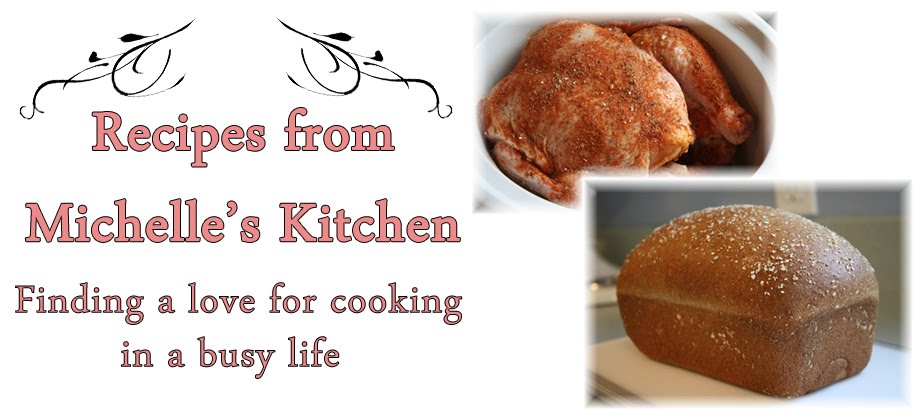If you have any questions, leave me a comment below. :)
In the bowl of your stand mixer, combine all of the dry ingredients (see link above for recipe). *I make several batches of dry ingredients at a time, and store them in containers like this one (a quart size yogurt container). Pour into mixer bowl & stir (with paddle) to combine.

Pour water in a microwave-safe measuring cup. (I used 1 cup of water, since it's summertime. You use more in the winter.) Then I pour in 1/4 cup each of honey and vegetable oil. I found it's easiest to measure them all in the same cup- so rather than measure your water in one cup, and the honey & oil in another (while trying to scrape the honey out of the measuring cup), you just use one.

Microwave (mine takes about 30 seconds with room temperature water), then stir a little. The water is ready if it's between 110-120 degrees.

With mixer running, slowly add in liquid.

Once the dough is just combined, stop the mixer. The dough will look like this. Take off the paddle, cover bowl with a towel, and let it rest for a few minutes (5-10).


Put on dough hook, and knead on speed 2 for 8 minutes.

Dough looks like this after kneading- it's fairly sticky and might not seem done, but don't add any more flour unless it's super sticky- too much flour will make your bread dry. (It's okay for the dough to feel tacky, but if it sticks to your hands when you try to form it into a ball, add a tablespoon of flour and knead again briefly.)

When you pull off a small piece of the dough, and stretch it thin with your fingers, it should be a little transparent, like this. If it breaks before looking like this, knead it a little more (1-2 minutes at a time).

Take dough out of bowl, gather it into a ball, and pinch the ends under, like this. This becomes the underside of your dough ball, and when you flip it over, the top should be smooth.

Lightly grease a large bowl with a little bit of oil or nonstick spray; place dough in the bowl. (This is my 2-quart mixing bowl, and it's a good size for this) Cover with a piece of plastic wrap.

Place bowl in a slightly warm spot to rise. (I turn on my oven for a minute or two, turn it off, then put the bowl in. You want it a little warm for good rising, but not hot.) Rise until puffy, but not necessarily doubled in size, about 1-2 hours. In my warmed oven, I do 1 hr 15 min. While rising, grease an 8 1/2 x 4 1/2 (or 8 x 4) inch loaf pan. I put my hand inside a ziploc bag, and spread the Crisco that way. Make sure to get every part of the pan.

Dough is done with the first rise

Dump out the dough onto a lightly oiled work surface (I started using my pastry mat recently for this, and it works well with no need for extra oil or flour). Flatten gently with your fingers. Pat/spread it into an 8" wide rectangle. (Note- don't oil the surface too much, otherwise your dough won't roll up properly, and you'll have big air pockets in the bread.)

Starting with the 8" side, roll up the dough into a log. You want to roll it up tightly, but don't push too hard.

Pinch the end of the roll (on the bottom) together like this, then pinch the side ends together (and tuck them under the loaf if you can).

Roll over, and you have a shaped loaf!

(This next step is optional, if you want the top of your bread to look more interesting) Sprinkle some oat bran on your work surface, next to your loaf. Roll the dough into the bran, pushing down a little to help it stick.

Place dough in greased loaf pan (you want it to touch all 4 sides, or come close to it).

Cover loosely with lightly greased plastic wrap, and put in a warm place for its final rise. You want it to rise until the center has crowned about 1" above the rim of the pan. For me, this takes about an hour.

Towards the end of the rising time, remove the dough to the counter or stovetop, and preheat the oven to 350º. Here it's done rising & ready to bake!

Bake for 35 to 40 minutes (mine takes 35) or until loaf registers 190º on an instant-read thermometer inserted in the center. (If your bread is getting darker than you'd like, tent it lightly with foil after 20 minutes of baking.)

Run a thin spatula around the edges to help loosen the bread

Turn it out onto a rack to cool. Cool completely before slicing (if you can!). I often set mine in the microwave while it's cooling, so nothing (like flies or small children!) disturbs it. You can also put it in a paper bag. Just don't seal it up until it's cooled. (Tips on slicing the bread are in this post.)

Here it is, a soft, delicious, homemade whole wheat bread! You can't get this from a store! You'll even want to eat the crust & the end pieces. :)

I store mine in a plastic bread container after slicing, but you could also store it in a large ziploc bag. Enjoy, and happy bread-making!
(PS- Thanks to King Arthur Flour for this great recipe!)


















